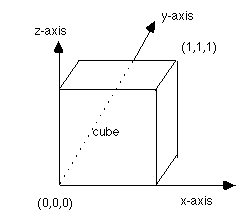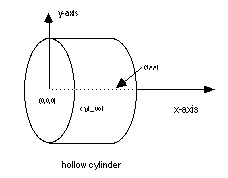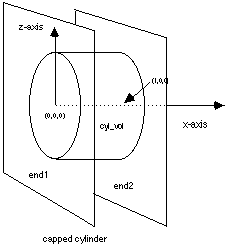2. Define an enclosing volume
Define an enclosing volume using the surface command. Since we are defining an exterior boundary, the boundary type is reflect. The next item of information needed is the geometry of the volume; some common geometry types are box, cylinder, sphere. Geometry types, box and sphere, define closed volumes; whereas a cylinder is open on both ends and must be capped by planes. Along with the geometry type, the extent of the volume is defined by specifying for the box its corners, or for the cylinder its radius and end point of its axis of rotation. The enclosing volume must be convex. Complicated enclosing volumes can be described by their bounding surfaces including planes and sheets . Some simple examples of enclosing volumes are:
Unit cube:
surface/cube/reflect /box/0.0,0.0,0.0/1.0,1.0,1.0
 “237” “212”
“237” “212”
Cylinder whose axis is the x axis with radius 1 and height 1:
surface/cyl_vol/reflect/cylinder/0.,0.,0./1.,0.,0./1.
surface/end1/reflect/plane/0.,0.,0./0.,0.,1./0.,1.,1.
surface/end2/reflect/plane/1.,0.,0./1.,0.,1./1.,1.,1.

